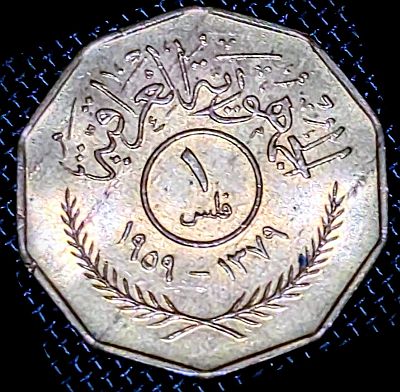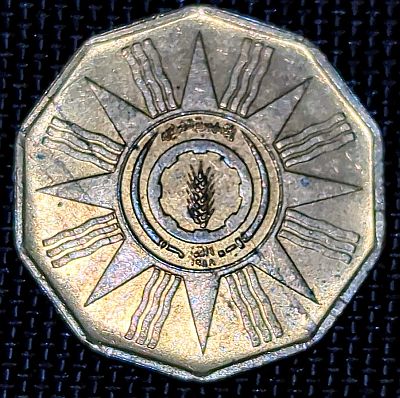The first Decagonal coin

The Decagon
When I posted about the 2018 Mauritania 20 Ouguiya, I noticed the coin next to it in the set, the decagonal 10 Ouguiya. A decagon is a shape with ten sides. Which of course got me thinking, what was the FIRST dodecagonal coin? It was the Iraq 1 Fils coin from 1959 (Islamic year 1379 – I ramble a little about Islamic years talking about the Morocco 1 Falus).
Numista lists only 73 Decagonal coins – including non-circulation coins. Normally I look mainly at circulating coins – I figure for something like this, you can do ANYTHING if you aren’t constrained by the practicalities of designing a coin which actually needs to survive circulation. In this case, if we limit to circulating coins only, the count is 43. Prior to 1970, there are only two; this piece and a 1967 1 Peso from Colombia (and I can’t promise never to do a post on tha coin, I do love Simon Bolivar’s hair).
Iraq
Called the “Cradle of Civilization” Iraq is one of the oldest regions of human occupation on Earth, with evidence of settlement back to 4800 B.C.
Starting a bit more recently, when the Ottoman empire was divided in 1920, what is now Iraq came under the “British Mandate of Mesopotamia“. The mandate ended when Iraq was accepted as a member of the League of Nations as an independent state in 1932. The country became the Hashemite Kingdom of Iraq. This monarchy lasted for 37 years. A coup d’état in 1958 resulted in the Republic of Iraq.
Coins
Since independence from the British Mandate, Iraq has used the Dinar as its currency.
- 1 Dinar = 5 Riyal (or 1000 Fils).
- 1 Riyal = 4 Dirham (or 200 Fils).
- 1 Dirham = 50 Fils
A series of coins were issued in 1959 following the coup, 1, 5, 10, 25, 50 and 100 Fils. A 500 Fils “Token” was also issued.
Obverse
The obverse of the coin features the country name in large, Arabic letters “الجمهورية العراقية” which translates as “Republic of Iraq”, the denomination in the centre, and the date in both Gregorian and Islamic years below. The value, ١, looks very much on a lean to me. The Arabic character does lean left compared to the western 1, although even compared to the other numbers in the Islamic year – ١٣٧٩ – it appears quite a bit more tilted.
Reverse

The reverse featured as the mystery coin in the 8th November 2023 newsletter. The design features a circle of 8 triangles alternating with 8 groups of three wavy lines. Interesting (to me) to have a design of 16 elements in a circle inside a 10-sided coin. The “cog” like circle in the centre has 8 cogs, with a sheaf of wheat in the very middle of the design.
The text above the cog again reads the country name. Below is the date of the revolution, July 14, 1958.
This series of coins was only produced in 1959, although a small number of proof sets (featuring at least the 100 fils) were issued in 1960. This “revolution” reverse design was used on each of the 1959 coins, and was not used again. This was perhaps partly because the next coins were issued in 1967, by which time there had been another coup. Althoguh the palm tree design on later coins is really nice, and may warrant another piece


Leave a Reply